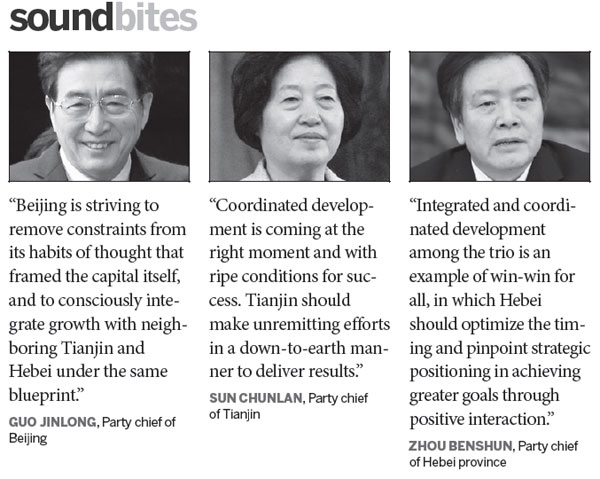Beijing holds the key to regional integration
 0 Comment(s)
0 Comment(s) Print
Print E-mail China Daily, March 13, 2014
E-mail China Daily, March 13, 2014
The dream of integrated development among Beijing, Tianjin and Hebei province will remain just that, experts said, unless existing barriers to the proposal can be hurdled.
The plan involving two major municipalities directly under the central government and a huge province is intended to not only ease congestion in the nation's capital but also to upgrade the industrial structure and treat the pollution in Hebei and develop the region into a new economic hub.
Beijing's gridlocked roadways and the smog shrouding 100 million people living on the 216,000 square kilometers that comprises all three areas have forced decision-makers to take a plan that first surfaced in 2011 and put it at the top of their priority list this year.
In an unprecedented move last month, Party chief Xi Jinping presided over a meeting on the initiative that was attended by leaders from the three areas.
"(The three) must complement one another, strengthen trilateral cooperation, deliver solid work and speed up searching for an integrated and coordinated method of sustainable development," said Xi.
The meeting is seen as spearheading an effort to put the plan in play.
The region's gross domestic product was $1 trillion last year, similar to South Korea's, and ranking 15th in the world. But the wealth is spread unevenly. The per-capita GDP of Beijing is $15,052, while Tianjin's is $11,541 and Hebei's only $6,336.
Along with this wealth gap is a patchwork of attitudes among the local governors toward the central government's proposal.
Hebei is supportive, Beijing is neutral and Tianjin's take can be described as wait-and-see.
According to Wen Kui, a researcher at Beijing's Capital University of Economics and Business, "There must be a central government-level authority to coordinate the three parties' actions and balance their interests.
"Despite their geographical proximity, Beijing, Tianjin and Hebei lack a developed private economy, industrial cohesiveness and openness, compared with the Pearl River Delta and the Yangtze River Delta," Wen added.
Tianjin went from being an international financial center at the start of the 20th century, to an industrial center from the 1930s to the '80s, to a city that today is "under Beijing's shadow", as many locals say.
As for Hebei, in 2012, 39 of its 114 counties were counted as below the poverty level. Of them, 25 surround Beijing and Tianjin within a radius of 150 kilometers.
By 2013, 8 million of the province's 73 million people still took home under $1 a day, and nearly 2 million of them lived near Beijing and Tianjin.
As the country's capital, Beijing is home to China's most elite universities, hospitals and decision-makers.
With strong financial support from the central government, Beijing can provide a much higher level of public service compared with other Chinese cities.
"The integrated development of Beijing, Tianjin and Hebei is of national importance," said Zhu Erjuan, a research partner with Wen Kui at the same university and the leading researcher of the government-sponsored project.
The central government must plan the regional development as whole, he said. Otherwise, it will be impossible to bridge the gap between the separate, and often competing, governing systems.
"The market should play a decisive role in allocating resources in regional integration," Zhu said. "The central government's coordination can serve to unify the local governors' actions."
The project has its foundation already in some fields.
There is a good infrastructure base in the three places after 30 years' fast development.
Beijing's location at the center of Hebei makes the province an immediate beneficiary of China's ambitious high-speed railway strategy, of which Beijing is a hub.
In the past few years, the length of high-speed railway track in Hebei has gone from zero to more than 5,000 kilometers. All cities and many main counties in the province will be connected by high-speed rail over the next two years.
The fast-developing railway and highway traffic nets, Hebei's and Tianjin's harbors on Bohai Bay, and the extension of Internet to grassroots communities all serve to connect the region.
Analysts believe that if Beijing can contribute more to integrating the regions - and there is a lot Beijing can and should do - the plan should see fruition. Helping Hebei modernize its industries already is a mandatory solution for cutting pollution in North China.
Hebei produces nearly 200 million metric tons of steel each year, more than the whole of Europe. The province also burned 300 million tons of coal last year, 5 percent of world's total. Of the 10 most-polluted cities in the world, half are in Hebei.
Led by the central government, Hebei has vowed to weed out its backward industries and digest the overcapacity in some of its pillar industries, such as iron and steel, sheet glass, cement and coal, within five years.
If more environmentally friendly industries can move to the province from Beijing and Tianjin, it will be a win-win development for the entire region.
The high price of land in Beijing, the lower labor costs in Hebei and the sound infrastructure in Tianjin make it a rational choice for the two cities to move some of their higher-tech and more modern industries to Hebei.
By agreeing to accept these newcomers as an integral part of its local economy, Hebei can boost its industrial restructuring and upgrading.
"The key is to lift the controls hindering production factors' free flow," Zhu noted.
"A more balanced industrial distribution across the region can help shorten the wealth gap between Beijing and Hebei and create conditions for a fairer allocation of resources and talent," he added.






